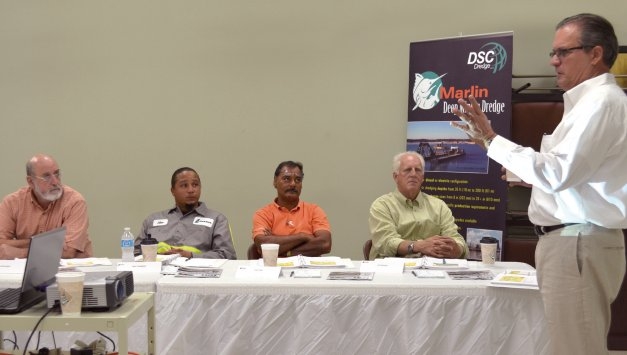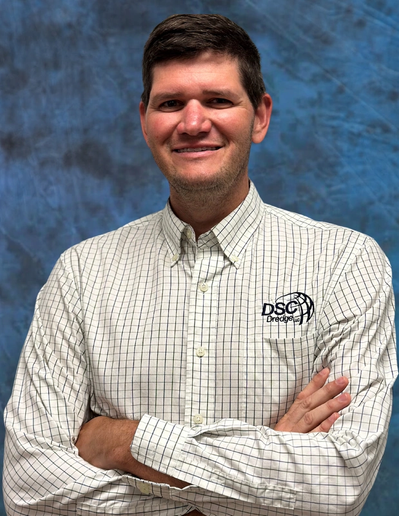Over the past seven years, Charles Johnson has developed a dredge operator training course that explains the basic functions of each dredge type, production and maintenance goals, and most important, how to achieve these goals.
As director of sales for DSC Dredge, LLC, in Reserve, Louisiana, Johnson is in a position to research every function and piece of equipment on a dredge, with the help of the veteran engineers and designers at the company.
Johnson designed the course to familiarize newly hired DSC engineers with real-world dredge operation, and it soon expanded to include sessions at customers’ facilities. He estimates that he has given the course to about 200 people since its inception in 2006. He emphasized that the course is not a sales pitch, but a generic discussion of the operation and maintenance of all types of dredging equipment.
On September 25, 15 engineers, dredge operators and managers assembled at Dredging Supply Company’s headquarters in Reserve for the eight-hour course. The group included six DSC engineers, two other DSC staff members, two dredge managers from Sevenson Environmental Services’ Lake Onondaga project, three operation staff members from LaFarge’s Louisiana sand and gravel operations, and one member of the press.
Johnson’s idea for this home-based session was to include a dredging contractor and an aggregate producer – two sides of the industry – to allow quality discussion between dredge users and DSC engineers and designers; and to allow DSC customers to provide feedback on their dredges.
On the Lake Onondaga project, Sevenson is using three DSC dredges. Brian Shanahan, superintendent of the project, and Michael Marrone, project engineer attended the session.
LaFarge is running one DSC dredge each in its Honey Island and Isabel, Mississippi, plants. James McKnight, plant manager for these operations, Allen Trepagnier, dredge operator at the Honey Island facility, and Bipin Patel, crusher operator, attended the training.
From DSC, Joe Bourgeois from accounting and Natalie Vicknair, human resources manager, joined the group. Ronald “Mac” McArthur, longtime draft and design engineer, attended, along with recently-hired engineers Eliot Castanza and Eric Leefe from electrical and automation; Jeremy Guedry and Sam Woodham from the mechanical engineering section; and Richie Fields, a design engineer. Linda DeFoe worked with Johnson to prepare the facility and the training manual.
Dredge Production and Efficiency
Johnson began with a discussion of dredge efficiency.
Dredging manuals and technical papers “only told how to figure (efficiency), not what makes up dredging efficiency,” he said. In an article he wrote for the National Stone Sand and Gravel Association (NSSGA), he proposed an industry standard for measuring efficiency, including in the equation utilization, downtime and the time available. He explained why downtime is not part of the utilization figure, and how production efficiency is an expression of the dredging requirements and the dredge’s design, compared to the peak production capability of the dredge’s on-board systems. He designed a “dredge efficiency analyzer” chart where 29 parameters, such as number of shifts, dredge length, swing angle, cutter diameter, dredging depth and advances per hour, among others, are combined to figure an overall efficiency percentage. In succeeding discussions, Johnson referenced this chart, changing certain parameters, to show the changes in efficiency when certain improvements or changes are made to the dredge or operating procedures.
“What Charlie is talking about is extremely important. A client wants to know the cost of production. Nothing is more important than this,” said Brian Shanahan.
“One yard is approximately 1.35 tons,” Johnson said. “In a sand and gravel operation that sells product for $8 a ton, it’s crucial to get a handle on the cost of producing each ton,” he said.
Showing a chart of a work day, Johnson demonstrated how non-producing time, such as initial safety meetings and downtime, are logged in separate categories, all expressed in percentages, which must add up to 100 percent.
As attendees followed along in the course booklet – a tabbed binder containing printouts of all the slides plus an appendix – Johnson went on to a discussion of efficiency techniques when dredging aggregates, including undercutting a bank to cause it to collapse. He explained that the geologic layers in a sand and gravel deposit each contain a different type and size of material, and that the goal is to mix these sizes as much as possible, especially when producing concrete sand, which requires a range of sizes. He described how a dredge operator can use certain methods to ensure this mixing.
Johnson then showed how dredge design impacts efficiency, using the example that a smaller ladder-down angle – 45 degrees instead of 55 degrees – will increase overall efficiency by about two percent, adding 17,586 tons per year in production. At $8 a ton, this equals $140,688 additional gross revenue, by making a change that costs nothing, Johnson said.
In another example, he explained that increasing the height of the dredge cut means the dredge remains in the cut longer and decreases the number of advances per hour. The dredge efficiency analyzer showed that this increased overall efficiency by about 12 percent, which translated to 272,874 additional tons per year, at an increase of $2,182,992 in annual gross revenue, achieved by a design change that cost nothing.
Johnson then discussed the different types of dredges and the proper type for the deposit to be dredged. “Everything on a dredge is sized to work harmoniously with all the other parts,” he said. To change one piece of equipment without changing all the others will cause failure in equipment that is not sized to handle the additional stresses.
Choosing a dredge requires analyzing the size and compaction of the material to be dredged, which sets the type and structure of the ladder, which determines the A-frame, which determines the winches, swing winches and size of the spuds, Johnson said.
Moving on to the effect of the digging tool on efficiency, Johnson discussed replaceable cutter edges and teeth, stating that the breakout force needed to cut the material determines if the tool can do the job. A smooth cutter edge has higher feeding efficiency if higher breakout force is not needed. The best all-around cutter is the serrated edge, which doubles the breakout force. A cutter with replaceable teeth focuses the forces onto points, increasing the breakout force by ten times.
When dredging in hard material, it’s important for the operator to adjust the cutter speed to the transport ability of the pumping system, he said. “A cutter blade only has a given number of passes in its life,” Johnson said, “so why run the cutter all out – for instance cutting at a rate of 800 yards and pumping at 600 yards – when you can’t transport everything you dredge?” Doing so increases the wear and therefore equipment cost, requires the dredge to swing faster than necessary, which increases the load on the hydraulic pump, and increases the electricity bill, Johnson said.
During the lunch break, attendees sat at the conference table with box lunches provided by DSC, and had a chance to discuss the morning session and exchange ideas. The class was held in the company’s Julia Bull Campbell Design Center, named after Robert and William Wetta’s grandmother.
Pump Operation
The afternoon discussion began with pumps, and Johnson’s graphic description of pump operation: “flow is created by continuous throwing of material off the impeller points.” The impeller is designed to provide sufficient pressure and flow rate to maintain turbulence in the slurry, which keeps the material suspended in the pipeline. He explained that larger diameter pipes require a higher velocity to create the same amount of turbulence, and that too little turbulence will plug a line. This can be caused by closing a valve or adding too much pipe, he said.
He explained the necessity of endplay in an impeller shaft, how to measure it and how to decide when it’s time to replace the bearings. If the bearings fail completely, the entire bearing assembly may have to be replaced, so this is an important item of preventive maintenance, he said.
A valuable tool for monitoring hydraulic motor life is the measure the case drain “- the hydraulic fluid that slips past the clearances of the motor and increases as the motor ages. This fluid is returned to the hydraulic reservoir and can be measured by installing a diagnostic flow meter or a case drain monitor (see photo on this page) can be permanently installed in the system.
“Few people measure case drains, but it is a good way to predict motor replacement,” Johnson said.
On the topic of preventive maintenance, he said that “everything mechanical will wear out,” so it makes sense to keep an inventory of spares on the shelf.
Johnson gave an intense description of pump operation and maintenance, explaining pressure, vacuum and impeller adjustment to measure the gap between the impeller and the front liner, with an excellent description of cavitation, how and when it is produced, and how it affects pump operation and pump wear. He described in detail how the operator can maintain production by adjusting pump and swing speed, particularly when the nature of the material changes.
He suggested buying an electronic thickness gauge and measuring pipe thickness regularly, rolling the pipe when the walls begin to thin, and also to keep tabs on the hull and pump case thickness.
Other Items of Interest:
– a four-vane impeller will increase production by only about a 1½ percent, so unless a customer is sure he will always be dredging in small material, it is better to go with a threevane impeller and ensure that all sizes and possible debris can pass through the pump;
– dredges equipped with a standard marine transmission and a CAT industrial diesel engine, the discharge pipe is typically on the port side because the industrial engines have only one rotation direction, and this is also why the cutter rotates so it is undercutting when swinging from port to starboard;
– typical anchor positioning is usually best at 10 o’clock and 2 o’clock, which allows for a 45 degree swing, while at the same time, keeps the cutterhead from coming into contact with the swing wire.
When starting a new cut in a gravel pit, Johnson stressed that it’s important to take time to develop the cut. When doing this the production rate will go down for a brief period, so it’s necessary for the production manager to understand what the operator is doing. A new cut is developed by creating “stair steps” that will allow the ladder to swing without scraping the bottom, and is achieved by making one cut then moving forward, making two cuts then moving forward and then three cuts, moving forward and begin producing again. If this is not done, it will perpetuate a bad bottom, Johnson said.
Attendee Feedback
At the end of the day, all attendees expressed appreciation for the training. The young DSC engineers said that they had not been familiar with dredging before being hired after graduating, and Mac McArthur, of DSC, who had a number of years of design experience, said that the training had given him information he didn’t have before.
Allen Trepagnier of LaFarge, the only dredge operator present, said that he had learned much to help him in his job.
Brian Shanahan of Sevenson said that the training gave him a better overall understanding of dredge operation.
Johnson has compiled feedback from all attendees of the training session over the years. A total of 202 people have taken the course, and they have said almost unanimously that they would recommend the training to others and that their understanding of dredging processes had been enhanced. While they say the presentation was not too technical, more than half stated that they are now prepared to attend a more technically advanced class. Most felt that the training would help their company’s productivity and efficiency. And nearly three quarters wanted to attend an annual seminar with other aggregate professionals.
Johnson teaches the class once a year in the New Orleans French Quarter, always on a Friday in the spring between March and May. Interested people can contact him at DSC at any time, and he will notify them when the date is set.
The training and accommodation is at the Omni Royal Orleans Hotel, with a special room rate that holds through the weekend, allowing attendees to visit the French Quarter for the weekend after the training





